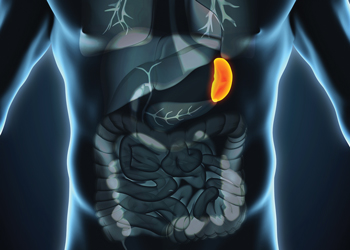After splenectomy, clots join infection as potential risks
Fewer splenectomies are being done, but thromboembolic disease afterward is now more recognized and therefore being diagnosed more frequently.
Physicians are gaining new respect for the spleen. Once thought to be of relatively little importance, the spleen's role in filtering blood and fighting infection is now seen as a major part of the body's defense system.
Along with better understanding of the organ itself comes the realization that losing the spleen can hold serious implications. Risk for infection after splenectomy is familiar, but blood clots and, by extension, pulmonary hypertension are emerging as another possible threat.

More knowledge of risk may be why fewer splenectomies are being performed in the United States. According to a 2014 study published in the Journal of the Society of Laparoendoscopic Surgeons, 7,050 splenectomies were done in 2007, 6,304 took place in 2008, 6,174 took place in 2009, and 5,998 took place in 2010. The most common causes of splenectomy are trauma and hematologic disorder. When categorized by gender, splenectomies are roughly split down the middle between male and female, with 45% of patients being men and 55% being women.
"Splenectomy is actually being performed less frequently, but thromboembolic disease following splenectomy is perhaps now more recognized and therefore being diagnosed more frequently," said Shelley Crary, MD, a pediatrician and associate professor of pediatric hematology-oncology at the University of Arkansas for Medical Sciences. "Internists probably see a few [splenectomized] patients a year."
Overwhelming postsplenectomy infection, or OPSI, is the best known and best understood splenectomy risk. The lifetime risk is only about 5%, but OPSI mortality rates run as high as 70%, although they are much lower with prompt and appropriate care.
Complications related to clotting, such as chronic thromboembolic pulmonary hypertension (CTEPH), also can increase following a splenectomy. And there is precious little information about how often that can occur or why.
According to a scientific review published in 2015 in the World Journal of Respirology, pulmonary vascular changes indicative of microthromboembolism appeared in 54% of splenectomized patients with thalassemia compared with 16% of those who had not had splenectomy. In a separate study noted in the review, splenectomized mice showed larger initial thrombi and delayed thrombus resolution.
The reasons behind CTEPH have remained elusive, but new research is starting to shed more light on the issue and on the important role of primary care in monitoring and treating patients after splenectomy.
Root causes
In the case of OPSI, the cause is fairly straightforward. With the spleen no longer present, all manner of bacteria, including Streptococcus pneumoniae and a host of other potentially harmful species, are no longer removed from the blood and can then cause infection.
"OPSI leads to sepsis, which can be fatal," said Ali Tavakkoli, MD, a gastrointestinal surgeon at Brigham and Women's Hospital in Boston. "That's what motivates people to try to preserve the spleen rather than remove it."
In the case of splenectomy-related blood clots, however, underlying mechanisms are trickier to discern. Immediately after surgery, patients may develop blood clots in legs or more commonly within the porto-mesenteric vessels.
"The etiology of these postoperative clots is not known," Dr. Tavakkoli said. "People have been trying to identify risk factors."
A study that Dr. Crary coauthored in 2009 for the journal Blood observed that acute portal vein thrombosis often occurred after splenectomy, but the various reasons behind that were unclear. The incidence of thrombosis involving the portal venous system after splenectomy ranges from 5% to 37%, all occurring within two months of surgery. It has become more common for splenectomy to be performed laparoscopically, and this confers a higher risk for these early postoperative thrombotic events, according to Dr. Tavakkoli.
"Those are seen in the veins around the spleen after surgery in 15% to 19% of cases," he said, "but it tends to be in people with a hematologic malignancy or people whose splenic vein is large."
The onset of CTEPH is slower and its etiology is less clear. New studies are helping to enhance understanding. In 2014, a report in the Journal of the American Heart Association revealed that tiny particles circulate in the bloodstreams of splenectomized mice. The particles, made from platelets, were found to foster coagulation and, thus, conditions like CTEPH.
"After splenectomy, an increase in circulating microparticles and negatively charged phospholipids is enhanced by experimental thrombus induction," the study authors wrote. "The initial increase in thrombus volume after splenectomy is due to platelet activation, and the subsequent delay of thrombus resolution is due to inhibition of thrombus angiogenesis. The data illustrate a potential mechanism of disease in CTEPH."
A 2016 study in the Proceedings of the National Academy of Sciences helped illustrate how the spleen filters blood. Red blood cells travel through tiny slits in the spleen, which helps give the cells their distinctive shape and screens out malformed or diseased blood cells that are unable to push their way through.
"Persons living without a spleen may have somewhat compromised immune response," said study coauthor Ming Dao, PhD, a principal research scientist with Massachusetts Institute of Technology in Cambridge. "It's one less immune organ that's not functioning. Old, stiff red cells still have to go somewhere. We don't know much about where they go, but they have to go somewhere. That could be in undesirable places in small capillaries, causing trouble in microcirculation, compromising the ability of tissues getting oxygen."
These old, unfiltered red blood cells may essentially cause thrombosis at the microcapillary level, usually just three or four microns wide, but Dr. Dao said the clinical implications of this finding require more research.
"There may be a better way to manage that situation," he said. "But it's not clearly studied yet."
Managing patients
In the meantime, splenectomized patients can be fairly easily managed in the internist's office. Although OPSI remains the top risk, thrombosis and related conditions are becoming a greater point of emphasis.
"This has the same signs and symptoms of any thrombosis," Dr. Crary said. "If you had a splenectomy, on an ongoing basis you just have to be cognizant of risk factors and monitor for symptoms of thromboembolic disease … Patients need to be educated in what to look for. If the primary care provider has experience managing thrombosis, there's no difference in the management of it in the case of splenectomy."
Although many internists are, for reasons related to resistance and other factors, prescribing fewer antibiotics, in the case of postsplenectomy patients antibiotics can and should be a part of preventive measures related to OPSI and should be prescribed liberally when potential signs of infection appear. Cold-like symptoms are typical of OPSI and similar conditions.
"If a patient presents with fever or just general cold and cough kind of symptoms, the recommendation is to have a lower threshold in treating with antibiotics," Dr. Tavakkoli said. "If a patient is traveling, they could even want to take a course of antibiotics just to have them on hand and use if they develop signs of an infection."
Dr. Crary recommended continuing years-long or even lifelong prophylactic penicillin when indicated for potential infection. "Given the high risk of postsplenectomy infection, if there's a fever over 101°F, administer parenteral antibiotics and obtain blood cultures," she said.
Of course, if symptoms worsen, inpatient admission may be the proper call. "If they don't respond quickly to antibiotics," Dr. Tavakkoli said, "you can seek out care at the hospital, with blood tests and broad spectrum of antibiotics."
Vaccination schedules are very important for splenectomized patients. "To minimize the risk of OPSI, patients should get vaccinated," Dr. Tavakkoli said. The CDC, in its 2016 recommendations for adult immunizations, counsels clinicians to provide the meningococcal 4-valent conjugate or polysaccharide, meningococcal B, and haemophilus influenza type B vaccines to all patients without a spleen.
Researchers said studies will continue on spleen-related clots and infection to gain a broader sense of how the spleen functions and what it means to live without one.
"There is a lot of interest in the spleen," said Dr. Dao. "It's a fascinating organ."



